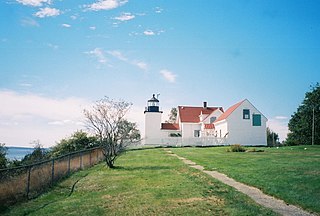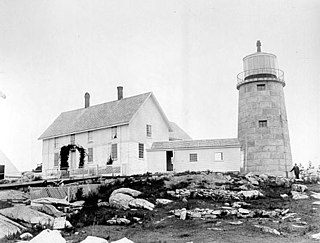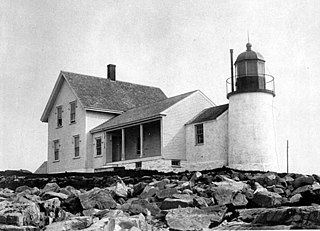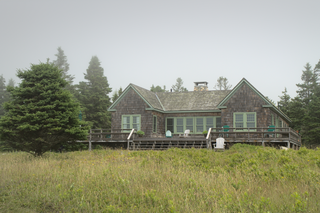Eleanor Mayo (1920–1981) was an American novelist of the mid twentieth century. She lived most of her life on Mount Desert Island, Maine. She was raised in Southwest Harbor, Maine. She was the life companion of the well known Maine novelist Ruth Moore. Mayo was introduced to Moore in the summer of 1940 by the latter's sister who had been Mayo's high school teacher. Mayo accompanied Moore on her return to California. The two soon moved to New York City where they remained until returning permanently to Maine in 1947. Mayo published five novels during her life. Mayos's novel Turn Home was made into the 1950 film Tarnished.

Bass Harbor Head Light is a lighthouse located within Acadia National Park in the southwest portion of Mount Desert Island, Maine, marking the entrance to Bass Harbor and Blue Hill Bay.

The Fort Point Light, or Fort Point Light Station, is located in Fort Point State Park, in Stockton Springs, Maine. A lighthouse at this point has served as an active aid to navigation since 1835; the present lighthouse dates to 1857, and is listed on the National Register of Historic Places.

The Edsel and Eleanor Ford House is a mansion located at 1100 Lake Shore Drive in Grosse Pointe Shores, northeast of Detroit, Michigan; it stands on the site known as "Gaukler Point", on the shore of Lake St. Clair. The house became the new residence of the Edsel and Eleanor Ford family in 1928. Edsel Ford was the son of Henry Ford and an executive at Ford Motor Company. The estate's buildings were designed by architect Albert Kahn, its site plan and gardens by renowned landscape designer Jens Jensen. The property was listed on the National Register of Historic Places in 1979, and was designated a National Historic Landmark in 2016.

The Brown House is a historic house at 384 Tremont Street in Rehoboth, Massachusetts. This 2+1⁄2-story wood-frame house has an unusual construction history. According to a local history, at its core is a structure built in the early 18th century, which was significantly modified and extended in the late 19th century with vernacular Italianate styling. The architectural evidence supports the idea that part of the house was in fact built in the 18th century.

The House at 19 Tremont Street is the smallest extant 19th century worker's cottage in Stoneham, Massachusetts. Built c. 1850, it is a stylistically vernacular single-story wood-frame structure, four bays wide, with a side gable roof, clapboard siding, and a brick foundation. Its only significant decorative features is its entry, which has sidelight windows typical of the Greek Revival period. It is the best surviving example of what was once a row of worker cottages that lined Tremont Street.

Egg Rock Light is a lighthouse on Frenchman Bay, Maine. Built in 1875, it is one of coastal Maine's architecturally unique lighthouses, with a square tower projecting through the square keeper's house. Located on Egg Rock, midway between Mount Desert Island and the Schoodic Peninsula, it is an active aid to navigation, flashing red every 40 seconds. The light was listed on the National Register of Historic Places as Egg Rock Light Station in 1988.

Hendricks Head Light is a lighthouse in Southport, Maine marking the west side of the mouth of the Sheepscot River. The light station was established in 1829, and its present structures date to 1875. It was deactivated in 1933, but relit in 1951. The two-story wood keeper's house is now a private summer residence. The light is on continuously, showing white to the west and red to the east. It was listed on the National Register of Historic Places as Hendricks Head Light Station on November 20, 1987.

Libby Island Light is a lighthouse on Libby Island, marking the mouth of Machias Bay, in Machiasport, Maine. The light station was established in 1817 and is an active aid to navigation; the present granite tower was built in 1823 and improved in 1848. Libby Island Light was listed on the National Register of Historic Places as Libby Island Light Station on June 18, 1976.

Perkins Island Light is a lighthouse on the Kennebec River in Maine. It was established in 1898, as part of a major upgrade of the river's lights — the Doubling Point Light and the separate Range Lights on the point, Perkins Island Light, and Squirrel Point Light were all built at the same time. It was listed on the National Register of Historic Places as Perkins Island Light Station in 1988.

Prospect Harbor Point Light is a lighthouse on Prospect Harbor Point, which divides Sand Cove from Inner Harbor at the head of Prospect Harbor on the southern shore of Gouldsboro, Maine. Also known as Prospect Harbor Light, it was first established in 1850. The present structure was built in 1891. It was listed on the National Register of Historic Places as Prospect Harbor Light Station in 1988.

Whitehead Light is a lighthouse on Whitehead Island, on Muscle Ridge Channel, in the southwestern entrance to Penobscot Bay, Maine. It is in the town of St.George. Established in 1804, it is one of Maine's oldest light stations, with its present tower built in 1852 to a design attributed to Alexander Parris. It was listed on the National Register of Historic Places as Whitehead Light Station on March 14, 1988. The property is now owned by not for profit Pine Island Camp. Whitehead light station offers to the public various stays at the light station from getaway weekends to learning retreats and renting the station as a vacation home. The light itself remains an active aid to navigation, maintained by the United States Coast Guard.

Winter Harbor Light is a lighthouse in Winter Harbor, Maine. It is located on Mark Island, a small island between the Schoodic Peninsula and Turtle Island, near the entry to the town's main harbor. The light was built in 1856 and was deactivated in 1933; it is no longer an aid to navigation, and is privately owned. The light was listed on the National Register of Historic Places as Winter Harbor Light Station on February 1, 1988.
The Ebenezer Knowlton House is a historic house on Choate Road in Montville, Maine. Built c. 1827, the property, which includes two period barns, is a well-preserved example of vernacular late Federal period architecture. The property is also notable as the childhood home of Rev. Ebenezer Knowlton, Jr., a Free Will Baptist minister and a trustee of Bates College in Lewiston, Maine, and Colby College, in Waterville, Maine. The house was added to the National Register of Historic Places in 2002.

The Black Horse Tavern is an historic tavern on Searsport Avenue in Belfast, Maine. Built in 1795, it was the city's first tavern located on the eastern side of the Passagassawakeag River, and is a well-preserved example of vernacular Federal period architecture. The building, now a private residence, was added to the National Register of Historic Places in 1982.

The Bass Harbor Memorial Library is the public library of Tremont, Maine. It is located at 89 Bernard Road in the village of Bernard, in an historically significant Colonial Revival building built in 1922 with funds donated by Tremont native Rhoda M. Watson. The building was listed on the National Register of Historic Places in 2009.
Shore Acres is a historic former summer hotel at 791 Lamoine Beach Road in Lamoine, Maine. With a possible construction history dating to about 1800, it is one of the coastal community's oldest buildings, and is the only surviving 19th-century hostelry in the town. Extensively altered in 1887 and operated as an inn between 1887 and 1942 as the Des Isles Inn, it is now a summer rental property, located within walking distance of Lamoine Beach State Park. The property was listed on the National Register of Historic Places in 2000.
The Bayside Historic District encompasses the historic core of a former religious summer camp meeting community in Northport, Maine, USA. It includes the original grounds of the Northport Wesleyan Grove Camp Meeting, established in 1848, with most of surviving architecture built between about 1870 and 1920. It is the largest surviving such area in the state, and was listed on the National Register of Historic Places in 1996. It is now the heart of the Bayside village, a secular seaside summer resort community.

Windswept is a historic summer cottage at 421 Petit Manan Point Road in Steuben, Maine. Built sometime between 1928 and 1934, it was from 1941 until 1955 the summer home of Mary Ellen Chase (1887-1973), one of Maine's most important regional writers of the period. It was the inspiration for her bestselling work, Windswept. The property was listed on the National Register of Historic Places in 2007.
The Whitehead Lifesaving Station was a maritime rescue facility on Whitehead Island, an island off the coast of St. George, Maine at the mouth of Penobscot Bay. Established in 1874 by the United States Life-Saving Service, its original building is one of the best-preserved of the five stations built by the service on the coast of Maine and New Hampshire at that time. The station was in active use until the 1940s, and is now privately owned. It was listed on the National Register of Historic Places in 1988.
















